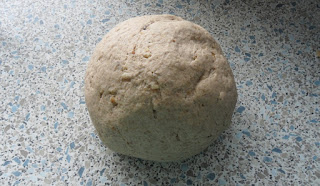The recipe: p420, "Rustic Walnut Bread"
Comfortably into the second half of the Random Kitchen year as we now are, it's no surprise to note that we've encountered most of the standard recipe types along the way: main courses, soups, salads, cakes, snacks, all have made their way onto this blog. I'm still waiting for a good non-cake dessert (chocolate overload pls kthxbai), but in the meantime, it's a warm welcome to a staple of the cookbook pages that somehow hasn't troubled us so far: bread.
Observant readers will have spotted that I like a good GIF almost as much as I like a bad pun, but I promise to try and steer clear of the most obvious contenders here. No "use your loaf", no complaints about the recipe being a pain in the arse, no groansome lines about what I "knead" to do next.
 |
| (There may be the odd exception.) |
The prep: I thought I had some fast-action dried yeast left in the cupboard from baking adventures in years gone by, but apparently not. Chances are I may have clocked the best-before date and thrown it out at some point (that'd make a pleasant change). Anyway, that goes on the shopping list along with the titular walnuts. Everything else - and, granted, it's a pretty short ingredient list - is already to hand.
At this point I decide to make a minor change to the recipe, replacing a small quantity of the plain white flour with rye flour in order to make the loaf ever so slightly less, well, white. While a long way from intolerant, out-and-out white bread doesn't seem to particularly agree with either of us, and the purpose of Random Kitchen isn't to make people feel actively unwell (even if the Spiced Cucumber recipe might have seemed like cruel and unusual punishment).
Granted, Sam doesn't particularly like walnuts either, but the concept of the blog dictates that I produce something at least vaguely approximating the actual recipe, so let's push on.
The making: The aforementioned mixed flours and some salt are introduced to a bowl. Butter is rubbed into the flour, then the dried yeast and "roughly chopped" walnuts are stirred in. Next, a well is formed in the middle of the flour mixture, tepid water is added (I do love a recipe that uses the word "tepid"), and subsequent stirring yields a suitably smooth dough. This is then turned out onto a floured surface and kneaded for a good ten minutes until nice and stretchy.
 |
| Dough ball |
In the next step, the above big ball o' dough is split in two. Yes, this is a BOGOF deal. And while two loaves is more fresh bread than a two-person household reasonably requires, the recipe helpfully notes that the end result is suitable for freezing, so we'll cope. Each of the dough portions is fashioned into a "roll" (the photo in the book helps to define this term more usefully), covered with a damp tea towel and left in a warm place for an hour or so until nicely risen.
 |
| All your perfect imperfections |
 |
| Double trouble, twofold huddle |
The eating: Generally pretty triumphant, though this was hardly likely to turn out badly.
I realise "rustic" is by no means synonymous with "heavy and challenging to eat", but I probably do associate it with a slightly darker loaf than this (and that's with my addition of rye flour). In this case, I suppose it's the simple ingredients/techniques and the haphazardly chopped nuts that are meant to give it that rough-and-ready edge, so I don't really have any grounds for criticism.
 |
| We make it and we take it home |
In any case, it makes for an excellent soup sponge, and the second loaf in the freezer (we may have destroyed the first one in a single sitting...) subsequently proves to be a robust toaster with jam for breakfast and an able bearer of cream cheese at lunchtime. Perhaps that's the true definition of "rustic" here - ready and willing to cope with whatever you might throw at it.
One-word verdict: Satisfying.





















